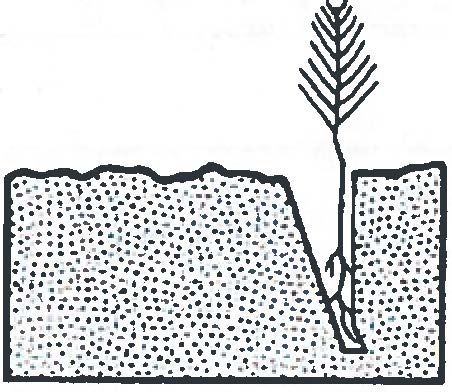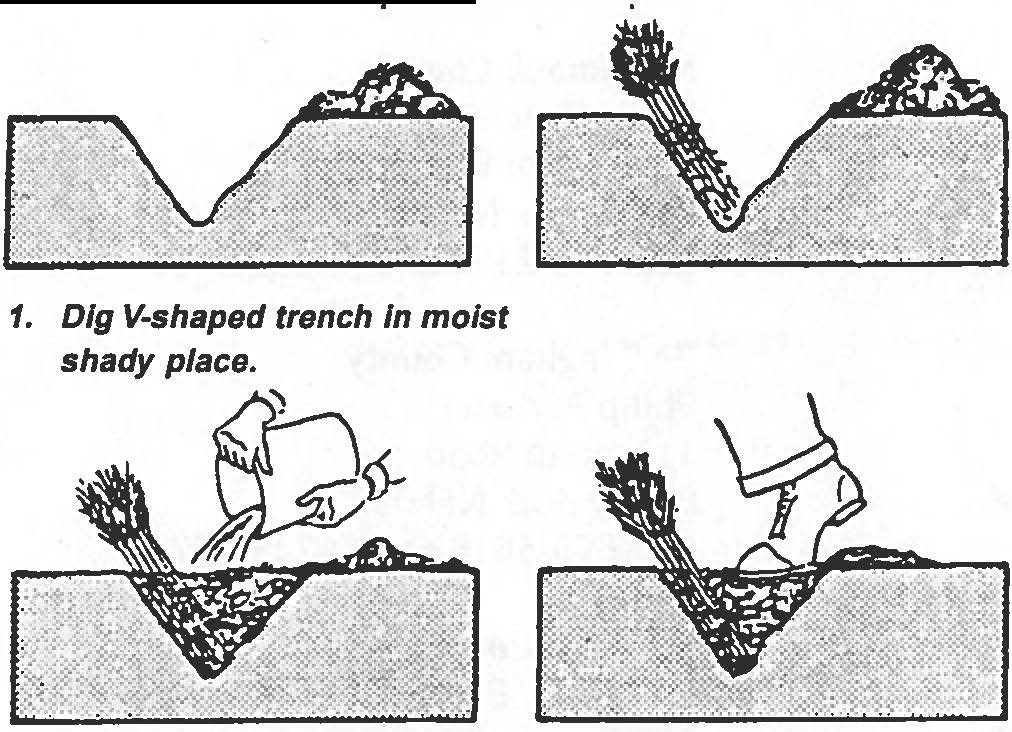When You Get Them Home
Your seedlings have the best chances for survival if you plant them as soon after purchase as possible. Store newly purchased seedlings in a cool dark location until they can be planted. If your seedlings are stored for more than a few days, open the bag and dampen the roots periodically. Don’t soak or leave the roots submerged in water while the trees are in storage.
When to Plant
Plant seedlings as soon as possible in early spring.
Plant seedlings as soon as possible in early spring. The suggested tree planting season in New Hampshire begins when frost leaves the ground and ends in late May. This period is most often ideal for tree planting because soil moisture is high, temperatures are relatively mild and the trees being planted are still dormant.
Late summer or fall plantings aren't as successful as spring plantings in our region and can result in higher seedling mortality. During this time of year, the period from mid-August through October is usually best. If weather conditions are dry, it often pays to wait until the following spring.



Trees may grow slowly for the first few years as they concentrate all their energy on root development during the "transplant shock" stage. Expect a certain amount of mortality. This will depend a great deal on how carefully they are planted and weather conditions during the early period of transplant shock.
Where to Plant
Trees and shrubs have soil and sunlight requirements that must be considered when selecting where they will be planted. All will do best if placed in sunny locations and in soils that have reasonably good drainage and ample topsoil. In reality, these conditions are often difficult to find and some compromises need to be made. However, there are limits to the extent that trees are able to adapt to adverse conditions. As a rule, never plant on sites that are very dry in the summer months or very wet in the spring. More detailed information about site selection and tree species requirements is available through UNH Cooperative Extension.
Types of Seedlings
The choice of planting method varies depending on the type, size and quantity of tree seedlings.
There are two types of seedlings available, bare root and containerized. Bare-root seedlings are grown in nursery beds for several years, lifted and packaged for shipment without soil attached. Bare-root stock can vary in age and size by the number of years it was in the nursery and whether or not it was transplanted into a second nursery bed for further development. The age and transplant history of bare-root stock is shown by standard number codes such as 3-0 or 3-2. A 3-0 seedling is grown for three years at a nursery without transplanting while a 3-2 seedling is actually a five year old "transplant." It is grown for three years in one bed, transplanted and grown for two more years before lifting.
Containerized seedlings or tublings, as they are often called, are grown in a greenhouse in specialized paper or plastic containers. Most often plastic trays are used which contain several dozen separate tubes for each seedling's root system. Tublings are grown for one season in the greenhouse and placed out in the fall to harden off. Because they are grown in a controlled atmosphere they are often similar in size to 3-0 bare-root stock.
How to Plant
There are two methods of hand planting bare-root seedlings: 1) the hole method and 2) the slit method. With the hole method, simply dig a hole with a shovel or a mattock large enough to accommodate the root system. Place the root system in the hole, spread out as much as possible and backfill only up to the root collar. Small quantities of seedlings are often planted using a spade and the hole method. With the slit planting method, drive a planting bar, spade or mattock into the soil. Rock the tool back and forth and twist to open a V-shaped slit in the ground. Place the seedling's roots into the slit and push the soil back firmly around the roots with one's foot.
In either the hole or slit method, it's critical to have the root collar be at the soil line and to firm the soil around the roots. The root collar is a line of change in the texture and color of the bark on the tree stem which shows where the soil line was before lifting at the nursery. If seedlings are planted too deep, their roots may not get enough oxygen. If they are planted too shallow, some roots may dry out. Similarly, if air pockets remain around the roots due to poorly firmed soil, roots may dry out and die. Pack the soil firmly enough around the roots so a vigorous pull is required to loosen the seedling.
Plant bare-root seedlings so roots are spread out as much as possible. Avoid unnatural J-shaped bends in the roots. This often occurs when root systems are stuffed into planting holes that are too small. Seedlings can also be damaged by twirling roots around each other or by leaving portions of the root system exposed above ground level. If absolutely necessary, prune some of the root tips off to fit the planting hole.

Planting Bar Method

angle shown and push
forward to upright position.

place seedling at correct
depth.

2 Inches from seedling.

firming soil at bottom of
roots.

bar forward, firming soil
at top of roots.
6. Fill in last hole by stamping
with heel.

with feet.
Use a dibble to plant tublings. When tublings are removed from their container the roots remain encased in the potting soil in which they developed. The end of the dibble closely matches the shape of the tubling's encased root system. The tool is simply pushed straight down into the soil, the tubling dropped in and the soil firmed up by foot pressure.
Whichever type of tree seedling, it's very important to keep root systems moist during the planting process. Carry small quantities of trees (50-100) at a time into the field. Reduce exposure as much as possible by keeping the root systems wrapped in wet burlap, peat moss or in a bucket with just enough water to cover the roots. Work as rapidly as possible during the actual planting process to minimize root exposure.


Heeling Trees In
If you can't plant tree seedlings within a week or two, it might be better to heel them in for planting in late summer or the next spring. Choose a site protected from wind and partially shaded. Water heeled-in seedlings heavily once or twice per week particularly during dry, hot weather.

2. Break bundles and spread out evenly.
3. Fill in loose soil and water well.
4. Complete filling in soil and firl with feet.
Spacing
Plant Christmas trees far enough apart to provide room for tree crowns to develop for approximately 10 years. Also, allow adequate space for maintenance and mowing between trees. A 6x6 foot spacing is considered the standard for Christmas tree plantations. This translates into 1,210 seedlings per acre. Other commonly used spacings are 5x5 foot (1,742 trees/acre) and 5x6 foot (1,452 trees/acre).
Number of Trees Per Acre According to Spacing
Spacing Number of Trees
5 X 5 1,742
5 X 6 1,452
6 X 6 1,210
7 X 7 888
8 X 8 680
9 X 9 537
10 X 10 435
Plant windbreaks and visual barriers so tree crowns will fully develop and branches remain alive close to the ground. The spacing is different for this application because trees will remain for their entire life span rather than the 10-15 years that Christmas trees are grown. Plant balsam and fraser fir at least 10 feet apart and all other species at least 15 feet apart.
Plant in groups or rows. Row plantings often require two or more staggered rows to work well. Some people plant twice the amount needed to give a quick barrier or screen. Every other tree is removed when they start to compete with each other.
Plantings to establish or reestablish a forest can be done using at least a 6x6 foot spacing. Here the goal is to grow tall straight trees. Plan periodic thinnings for the removal of excess trees. Recently cut-over areas often don't lend themselves to ideal spacing. In these situations, plant groups of seedlings in forest openings where overstory trees have been removed with 6 to 10 foot spacing (approx. 800 trees/acre) as the goal. Planting within one year of harvest isn't recommended due to possible insect problems.
Fertilizing
If you have chosen a relatively good site for planting, addition of fertilizer isn't necessary for seedlings to survive and grow well. Fertilization can supplement depleted soils and enhance the foliage color of Christmas trees. It's advisable to get a soil test for large plantations to be sure fertilization is necessary and, if so, that the correct nutrient ratio and application rates of fertilizer are used. Soil testing also provides information about the soil pH which is adjusted by adding ground limestone. Tree species require a soil pH of between 5.0 - 6.0. Soil conditions above or below this range won't allow trees to use available nutrients and may lead to wasteful applications of fertilizer.
While fertilization isn't necessary and isn't recommended at the time of planting there are slow-release products that can be placed directly in the planting hole. Annual or biennial spring fertilizing after that, with a complete fertilizer such as 10-10-10, gives seedlings a good start. Increase the application from a handful per tree to up to 2-3 handfuls per tree (approx. 8 oz.) by the time the trees are 10 years old. Trees planted in regularly fertilized lawns don't usually require additional fertilization. In lawn plantings, avoid using fertilizers with weed-killing additives that may damage young seedlings.
Weed and Brush Control
Give consideration to weed and brush control before planting. Untended, small seedlings often get overtopped by nearby vegetation. Competition for sunlight and space can severely affect young trees by slowing growth and in many cases causing death. Aggressive native vegetation is a real concern in reforestation plantings. Annual mowings are an expected routine maintenance in Christmas tree plantations where tree quality and growth rates are of utmost concern. Control of unwanted vegetation is also accomplished by other mechanical methods such as brush saws, registered herbicides and cultural methods such as planting low-growing ground cover. Specific recommendations are available.
